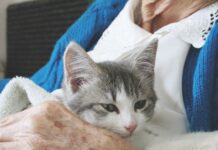Domestic cats, like many other mammals, use smelly secretions from anal sacs to mark territory and communicate with other animals. A new study from the Genome Center at the University of California, Davis, shows that many odiferous compounds from a male cat are made not by the cat but by a community of bacteria living in the anal sacs.
“Cats use a lot of volatile chemicals for signaling, and they probably don’t make them all,” said David Coil, one of the researchers.
Many species—including cats, dogs, bears, pandas, skunks, and hyenas—use anal sac secretions as a chemical language. Skunks, of course, also use them as a means of defense.
The researchers obtained anal sac secretions from a single male Bengal cat volunteered to participate by its owner. They extracted DNA for sequencing to identify types of bacteria and took samples for chemical odor analysis.
Sequencing showed that the microbial community was not very diverse and dominated by a small number of bacteria. The most abundant bacteria from the screen were grown in culture. A postdoctoral researcher analyzed the volatile chemicals given off by the bacteria, using a lab that focuses on technology for detecting and characterizing low levels of volatile organic compounds that can be markers of health and disease, from influenza to citrus greening in fruit trees.
The researchers detected 67 volatile compounds released by the bacterial cultures. Of these, 52 were also found directly in the anal sac secretions.
The results support the idea that the bacterial community, not the cat itself, produces many of the scents used by the cat to communicate. Coil and colleagues want to follow up by looking at more cats. If these scents are made by bacteria, why do cats smell different to each other? How do cats acquire the bacteria and do they change over life? Understanding how microbes influence their scent could have wide implications for understanding scent communication in animals. n
Yamaguchi, M.S. et al. Bacteria isolated from Bengal cat (Felis catus Prionailurus bengalensis) anal sac secretions produce volatile compounds potentially associated with animal signaling.PLOS ONE, 2019; 14 (9): e0216846 DOI:10.1371/journal.pone.0216846



